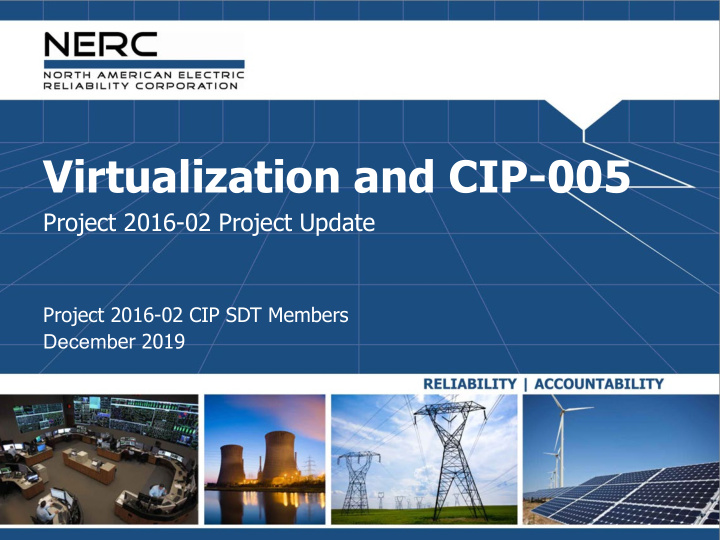



Virtualization and CIP-005 Project 2016-02 Project Update Project 2016-02 CIP SDT Members Decemb er 2019
Purpose Virtualization changes to CIP standards are to ENABLE new methods/models NOT REQUIRE Them 2 RELIABILITY | ACCOUNTABILITY
Agenda • Discuss current security state and issues • Discuss emerging security models (Zero Trust) • CIP-005 changes to allow ESP plus other models 3 RELIABILITY | ACCOUNTABILITY
Current State • Network Perimeter (ESP) based • Castle & Moat Everything inside the castle = good All the bad is outside the castle The moat (FW) provides separation and controlled access • Trust is based on your network location Internet, Corporate network, DMZ, ICS network, Controller network Your trust level = Which perimeter are you within Security controls are mostly for North/South traffic (crossing perimeters) All your network peers are same trust level (PCAs in CIP) East/West traffic within the perimeter has no security controls 4 RELIABILITY | ACCOUNTABILITY
Typical Network Model Internet Corporate Control System Accounting Network Engineer Dept Desktop Desktop DMZ Network Data Historian Database Server Control System Operator Network HMI 5 RELIABILITY | ACCOUNTABILITY Controller(s)
Issues • Adversaries are intelligent, highly adaptable, often with more resources than defenders • As perimeter model improved -> Attackers adapt and hack the humans instead (phishing, watering hole attacks, etc.) • Result – the “inside” is also hostile and the model provides for easy lateral movement (network access controlled at perimeter, not inside) • Ransomware – get on one system inside the perimeter and spread laterally 6 RELIABILITY | ACCOUNTABILITY
Typical Security Breach Internet Corporate Control System Accounting Network Engineer Dept Desktop Desktop DMZ Network Data Historian Database Server Control System Operator Network HMI 7 RELIABILITY | ACCOUNTABILITY Controller(s)
Other Perimeter Issues • Remote access, VPN, Cloud services, Vendor access, etc. • The true perimeter is dynamic • “Inside” and “outside” a perimeter – is there another way to think about network security models? 8 RELIABILITY | ACCOUNTABILITY
Virtualization Enables Other Models Virtualized environments are enabling new and different ways to think about network security to address these issues Security controls – network or host Network – isolation, but lose context Host – context but not isolation Enter the Hypervisor with ubiquitous context 9 RELIABILITY | ACCOUNTABILITY
Zero Trust Architecture • New and evolving security strategy that fundamentally changes networking from implicit trust to zero trust • The basic premise is there is no implicit trust granted to systems based on their physical or network location Treats EVERY network as hostile (thus the zero trust name) DOESN’T CARE what network address you have or where you are DOES CARE who you are as a person or process, the state of your machine, whether you are authorized RIGHT NOW for what type of access to the particular data or resource ALL traffic is encrypted/protected because no network is trusted • ONLY authorized communications are allowed 10 RELIABILITY | ACCOUNTABILITY
Security Breaches in Zero Trust This Photo by Unknown Author is licensed under CC BY-NC-ND 11 RELIABILITY | ACCOUNTABILITY
Zero Trust Model • Assumes ANY network is hostile - NO implicit trust • Access granted only when access needed and only for duration of access • Authorize the user and device at the time access is needed • Protects resources and data, not network segments • Network location is no longer a prime component of security posture • Attacker reconnaissance and lateral movement not allowed • This is a fundamentally different model than ESP 12 RELIABILITY | ACCOUNTABILITY
Policies and Zones • Network segments and perimeters replaced with policies and zones • Based on “need to know” preconfigured access policies • Protects access to data, assets, applications, and services, not network segments • Policies can include machines, users, processes, services regardless of where they are on a network . • Get access control as granular as possible. 13 RELIABILITY | ACCOUNTABILITY
Policy Example • Individuals in AD group “Historian_Access” on a device with OS=“Windows” can only use TLS-Version =“1.2” encrypted communication to access workloads with Tag= “Control_Historian_APP” • This policy defines allowed communications • With no reference to where anything is on a network • An encrypted temporary “network” is established between the user/process/app wherever they are to the historian app wherever it is • No other communication allowed • Policy is enforced end to end and everywhere in-between 14 RELIABILITY | ACCOUNTABILITY
CIP-005 • Current • 1.1 All applicable Cyber Assets connected to a network via a routable protocol shall reside within a defined ESP. • 1.2 All External Routable Connectivity must be through an identified Electronic Access Point. • Proposed • 1.1 Have one or more methods for allowing only needed and controlled communications to and from applicable systems either individually or as a group and logically isolating all other communications. 15 RELIABILITY | ACCOUNTABILITY
Hybrid Models • Typically not “either/or” network models • Hybrid environments will be the norm • Security objectives allow for current/future/hybrid models 16 RELIABILITY | ACCOUNTABILITY
ESP Conforming Changes • PCA • Current – One or more Cyber Assets connected using a routable protocol within or on an ESP… • Proposed – Cyber Assets that are not logically isolated from a BES Cyber System… • 4.2.3.2 Exemption • Current – Cyber Assets associated with communication networks and data communication links between discrete ESPs. • Proposed – Cyber Assets associated with communication links logically isolated from BES Cyber Systems or SCI. 17 RELIABILITY | ACCOUNTABILITY
Future Steps • Three CIP Standard Drafting Teams • BCSI / Cloud • Supply Chain • CIP Modifications (Virtualization) • Project 2016-02 will delay posting until other SDT’s reach final ballot • Outreach • Mini Webinars • NERC Technical Workshop in Spring 2020 18 RELIABILITY | ACCOUNTABILITY
Questions and Answers Jordan Mallory NERC Senior Standards Developer for Project 2016-02 CIP Modifications Jordan.Mallory@nerc.net 19 RELIABILITY | ACCOUNTABILITY
Recommend
More recommend